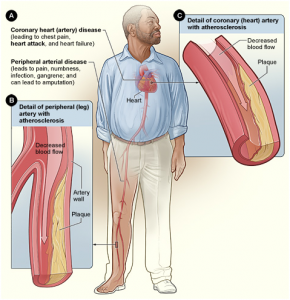 Developing a non-healing wound can be one of the most serious and devastating complications for a diabetic patient. These wounds or open sores are also called diabetic ulcers, and they frequently occur on the foot. Diabetic foot ulcers are prone to infections, and this puts patients at a higher risk of hospitalization and need for surgery or amputation.
Developing a non-healing wound can be one of the most serious and devastating complications for a diabetic patient. These wounds or open sores are also called diabetic ulcers, and they frequently occur on the foot. Diabetic foot ulcers are prone to infections, and this puts patients at a higher risk of hospitalization and need for surgery or amputation.
A diabetic foot ulcer may begin like a normal wound. It might be a cut, scrape, blister, or other minor injury. Unlike normal wounds that heal naturally over a few days, a diabetic wound fails to heal properly.
In diabetic patients, these poorly-healing wounds can be associated with two major complications:
Neuropathy
Patients who have diabetes for many years can develop neuropathy, a reduced or complete lack of sensation due to nerve damage. A common symptom of neuropathy is numbness, which causes a diminished ability to feel discomfort and pain. As a result, a patient suffering from neuropathy will not necessarily be aware that they have a cut or a blister, even if it means a potential harm to the body.
Peripheral Vascular Disease
 The risk of getting peripheral vascular disease is increased in diabetic patients, since high blood sugar damages and weakens blood vessels. Peripheral vascular disease often results to a decreased blood flow to the legs and feet. If you have a wound, consistently strong circulation is important to help red blood cells deliver nutrients for faster healing. Without strong circulation, diabetic patients become even more vulnerable to infections.
The risk of getting peripheral vascular disease is increased in diabetic patients, since high blood sugar damages and weakens blood vessels. Peripheral vascular disease often results to a decreased blood flow to the legs and feet. If you have a wound, consistently strong circulation is important to help red blood cells deliver nutrients for faster healing. Without strong circulation, diabetic patients become even more vulnerable to infections.
Prevention of Diabetic Foot Ulcers
Non-healing foot ulcers are proven to be preventable in a number of ways:
- Visit your endocrinologist regularly.
To better manage your diabetes, an endocrinologist can help by monitoring your Hemoglobin A1C (HbA1C) test, which is a three-month average of your blood sugar level. They will also check your feet, make sure you have good circulation, and address any problem you may have encountered since the last visit.
- Check your blood sugar everyday.
Regular blood sugar monitoring is the most important thing to do when managing diabetes. It can help you record changes in your blood sugar levels and identify which activities affect them.
- Avoid walking barefoot.
Wearing house slippers is a good way to protect your feet. Socks are not enough because some objects can easily pierce through it and hurt your feet.
- Check for foreign objects inside your shoes.
Before wearing your shoes, make sure that they are free from any foreign object. This might be a stone, a tack, or anything that can cause an injury to your foot.
- Inspect your feet before going to bed.
Regularly check for wounds or red areas on your feet and in between your toes. If the patient is unable to perform this task themselves, a family member should be taught how to assess foot health.
Treatment of Diabetic Foot Ulcers
If you notice or suspect a non-healing wound on your foot, it is important to seek podiatric care immediately. Diabetic wounds are not the type of wound to be treated at home on your own.
Early diabetic wound treatment is vital to reduce the risk of infection and amputation, improve function and quality of life, and reduce healthcare costs.
Specific measures include:
This process involves the removal of dead and infected tissue. Debridement can also expose the real wounds and help your doctor evaluate the extent of your injuries.
Patients may be asked to use crutches, special footwear, a brace, or other devices. Reducing pressure and irritation helps ulcers heal faster.
Appropriate wound management includes the use of dressings and topically-applied medications. These may be saline, growth factors, or skin substitutes that have been shown to be highly effective in healing foot ulcers.
- Hyperbaric Oxygen Therapy (HBOT)
The oxygen-rich environment in the HBOT chamber allows cells to take oxygen to the wound more efficiently and helps to kill the bacteria in infected wounds.
In cases when non-surgical treatments do not work, a surgeon can help alleviate pressure around your ulcer by shaving down the bone or removing foot abnormalities such as bunions or hammertoes.
Look no further if you have a non-healing foot ulcer and want to get treated by one of the best foot and ankle doctors in Houston, TX. DeNiel Foot & Ankle Center‘s podiatrist is well-equipped to treat all sorts of diabetic foot wounds. If you’re looking for a new foot specialist, give them a call to set up an appointment.
Comments
[…] often affected by this form of nerve damage. As you may be aware, this disease raises the risk of foot ulcers and perhaps amputation. If you have neuropathy, you should pay special attention to your […]
Comments are closed.